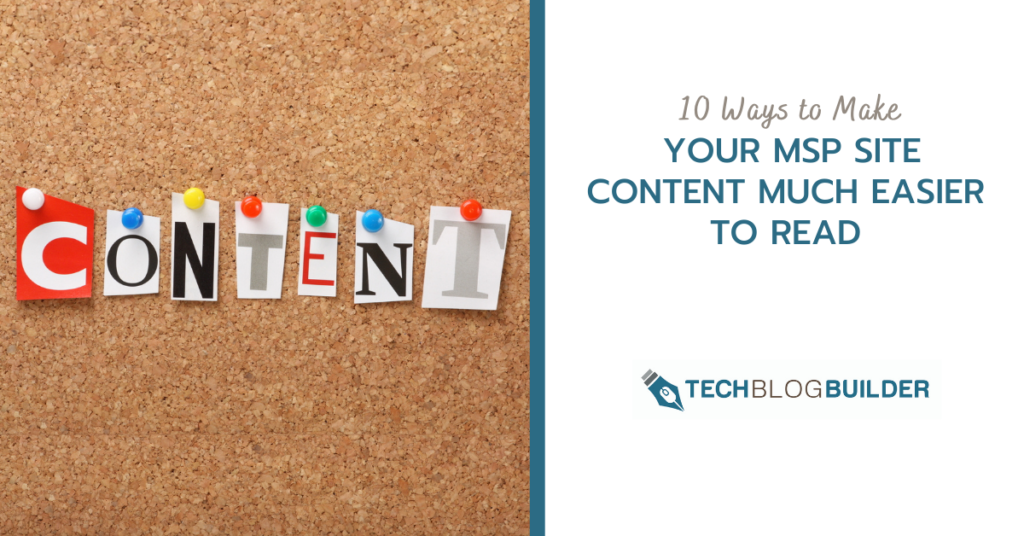You may have amazing content in your blog posts, but if they’re not easy to read, they could be gathering virtual cobwebs. Paragraphs that go on forever and a page of text with no headings can look to a visitor like a lot of work rather than an engaging read.
With just a few tips under your belt, you can make your MSP website content much easier to read, drawing in more visitors that you can then convert to leads.
Giving your blogs structure not only makes them more inviting to readers, it can help you create more compelling marketing content and boost your SEO.
How to Structure Your Content for Better Readability
If someone lands on a webpage that looks like one big block of text with no heading or other elements that make the content easy to digest, they’re likely to bounce.
According to Inc., 38% of people will stop engaging with a website they find unattractive.
If your blogs and other website content don’t seem to be bringing in the leads that you expected, it might be due to poor formatting that’s too difficult to read and turns visitors off.
Let me give you an example. Below is some text from one of our past blogs. On the left, I took away all the formatting, on the right is the blog in its original format.

You can see how the text being broken up by headers and bullet points makes it easier to read, where a big block of text makes a page harder to for someone to get through.
And however difficult it looks on a computer screen, multiply that by 10 on a mobile screen! If you aren’t formatting well, then a long paragraph can be even longer when viewed on a smartphone.
Mobile devices account for 52.6% of all global web traffic.
Over half of web traffic comes from mobile devices, so you should be formatting your blogs and other website pages with that in mind, making them as easy to read as possible on any size screen.
Here are some tips for content with better readability.
Use Headings & Subheadings
The use of headings and subheadings help break up large blocks of text and also give the reader a cue to what the next paragraph may hold.
For instance, when you look down this blog, you can pick up the main points, from the subheadings, making it easy for you to zero in on the subtopics that you want to know more about.
You should use a different size font for headings and subheadings, which helps the reader know when there is a major topic change and which topics fall under the main one.
Make sure to keep consistency between all the headings (same font/style/size) and subheadings (same font/style/size) so readers can identify them easily and understand the pattern.
Use of H1, H2, H3 in programs like WordPress can also gain you points with your SEO. Google likes that structure because it makes it easy for the reader. Using keywords in those headings and subheadings boosts your overall search optimization.
Break Up Long Lists With Bullet Points
When you put a list of words in one long sentence, it’s much more difficult to pick out each item. They all kind of run together. But put them into a bullet point format, and it’s much easier to read in a glance.
Check out these two formatting examples. Which is easier to read?
Poor formatting:
When you layer cybersecurity, you need to include antivirus/anti-malware, a next-gen firewall, a password manager, patch and update management, cloud application security, endpoint device management, and managed backup.
Good formatting:
When you layer cybersecurity, you need to include:
- Antivirus/anti-malware
- Next-gen firewall
- Password manager
- Patch and update management
- Cloud application security
- Endpoint device management
- Managed backup
You can also use the numbering bullets, for example if you’re providing a list of steps. People’s eyes will naturally move to bulleted lists because of the readability.
Use Illustrations & Images
Web pages and blogs with images get 94% more views than those without them. Use of images and illustrations can help you reduce your bounce rate for a page, and it helps break up text and make the page easier to read.
What you state in several paragraphs can easily be summed in a single image or graphic, which allows your main point to be better grasped by the reader.
One of my “secrets” for illustrating points in a blog is to use Microsoft Word’s SmartArt tool. They have several great graphics that you can easily use to illustrate a particular point. You can also change the color scheme to match your brand at the click of a button.
Here’s an example of one of our SmartArt illustrations for a blog on sister site, Tech Reputation, about the importance of star ratings.

In just one glance, several lines of text about different star ratings all come together for the reader, making for a better experience for them and a page that’s easier to read overall.
Keep Paragraphs to 3-4 Lines of Text Max
Remember what I said about writing for small mobile screens? This is especially true with this next tip. You want to keep your paragraphs to approximately 3-4 lines of text. Of course, what a “line” means is going to vary by the tool you’re using to write your content.
You can gauge it when typing in MS Word or within WordPress. You don’t want to make paragraphs show up to the reader as too long because they’ll be difficult to get through and you’ll start to lose people.
You’ll see that we try our best to always keep our blogs within that 3 to 4-line range, with a few exceptions if breaking up a paragraph just wouldn’t make sense.
This improves readability on even smaller screens.
Leave Plenty of White Space
Another way to improve the readability of your content is to ensure you’re leaving enough white space between headers, paragraphs, lines of text, and around images.
White space helps the brain organize the content without everything running together. It also creates a balance between the elements on a page and can be used to give the reader a visual pause before they move on to the next concept.
Watch Out for Run-on Sentences
If you have sentences that are running on for three to four lines of text, this can make it difficult for the reader to follow along. You want to watch out for run-on sentences and if you see one, look for ways you can break one sentence up into several.
For example, I could break up that last sentence into two to make it more readable: “You want to watch out for run-on sentences. If you see one, look for ways you can break one sentence up into several.”
Use Good Linking Practices
Hyperlinks are one of best practices for search engine optimization and they also help provide context and more information for a reader. However, if you aren’t using good linking practices, they can make your content harder to read.
Here are some tips for use of linking in your blogs and webpages:
- Don’t use too many hyperlinks or put them too close together or it looks “spammy”
- Hyperlink a few words (2-4) not an entire sentence, or the text is harder to read
- Hyperlink words that make sense (i.e., “more email tips” instead of “more”)
Highlight Important Details in Bold
You can quickly draw someone’s eye to an important point in your text by using bold text.
If used correctly, this helps you highlight an important marketing point in your content and makes it easier for a reader to get the main point of a paragraph of text.
Example without bold:
Blogs are a great way to improve your lead generation and sales. They boost SEO and give readers a reason to come back to your site. If you don’t have time, a blog service can give you great content week after week.
Example with bold:
Blogs are a great way to improve your lead generation and sales. They boost SEO and give readers a reason to come back to your site. If you don’t have time, a blog service can give you great content week after week.
Notice how the bolded message stands out and makes someone more interested in reading on about how to improve their leads and sales.
As with hyperlinks, use bold text sparingly, otherwise it loses its effectiveness and reduces readability.
Make Sure You Have a Good Text/Page Contrast
We’re not in the late 1990’s anymore, so there shouldn’t be many pages with black backgrounds and florescent text out there in the MSP website world. However, there are still some pages that might not have enough contrast between the text and the page color.
Make sure you aren’t using greys that are too light or page blocks that are too dark. Your page text should be easy to read without people having to squint or zoom in to make out some of the words.
Use an Editor Application
Many word processing tools have built in editors that allow you to check not only spelling and grammar, but also readability. Editor in MS Word does this, and there are several other tools you can find online as well.
These tools help you spot things like long sentences, difficult to read paragraphs, and provide tips to improve readability.
Here are a few you can try:
Attractive Pages Drive More Conversions
When you pay attention to readability on your blog and webpages, your content is more attractive, driving more visitors, leads, and conversions.
Do you have any questions about formatting for readability? Just ask us in the comments!


